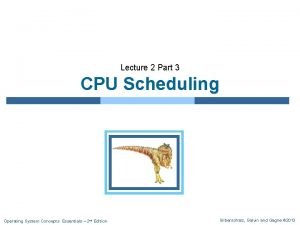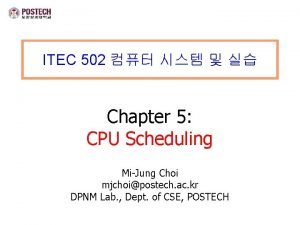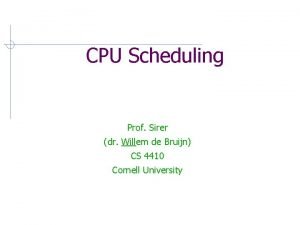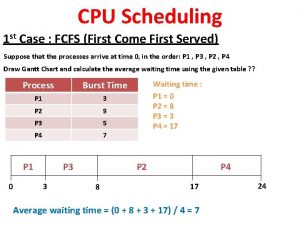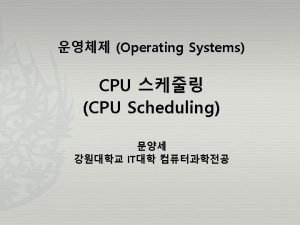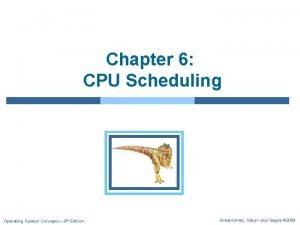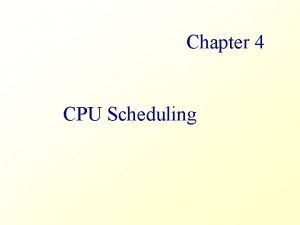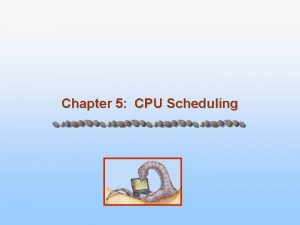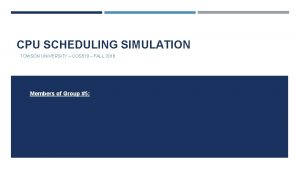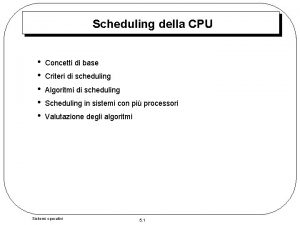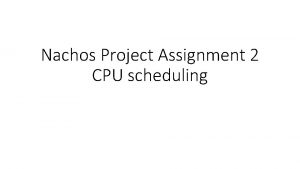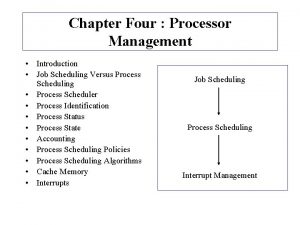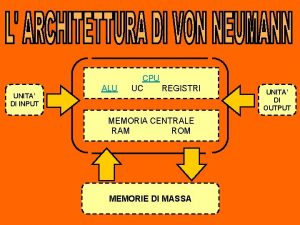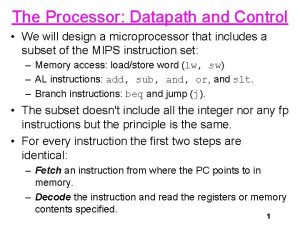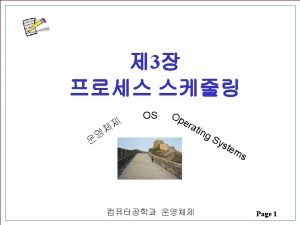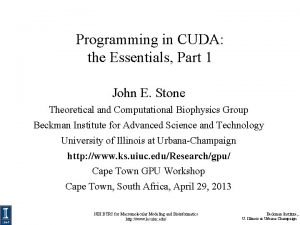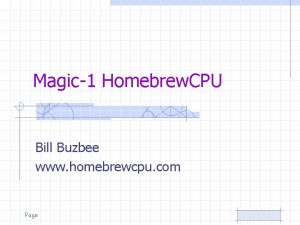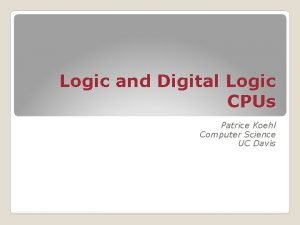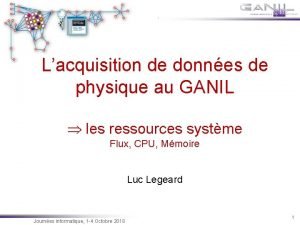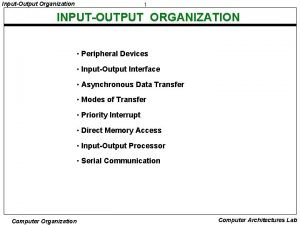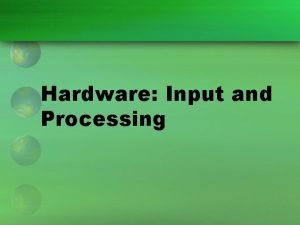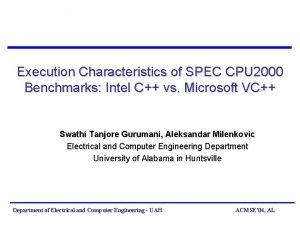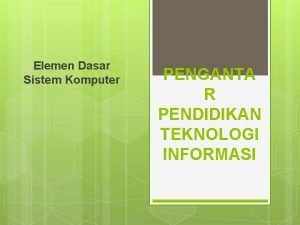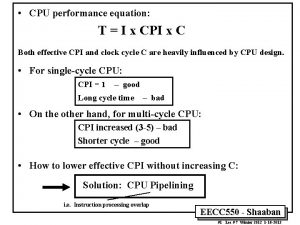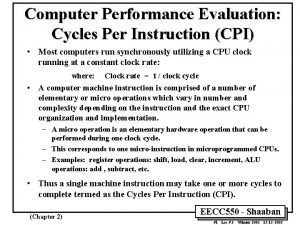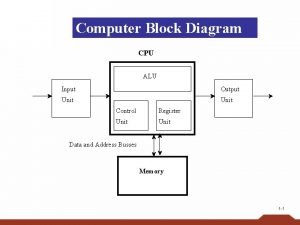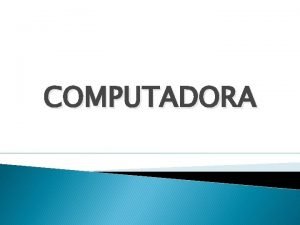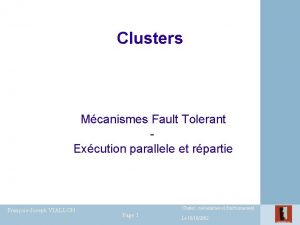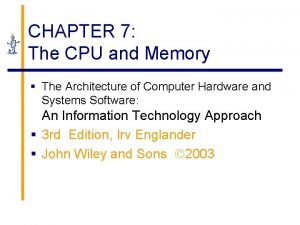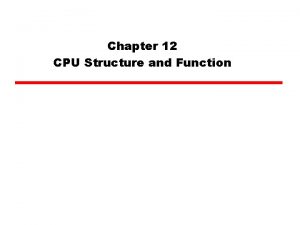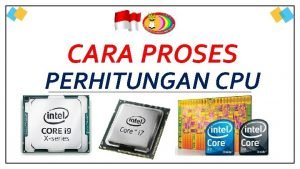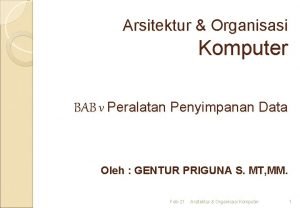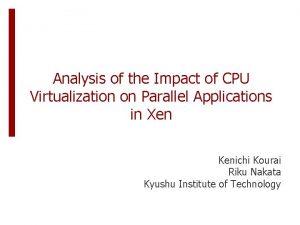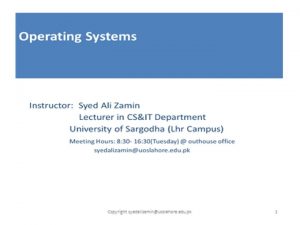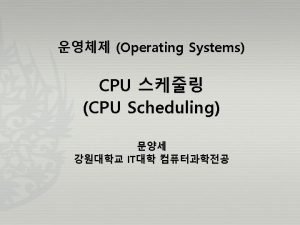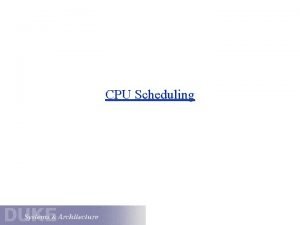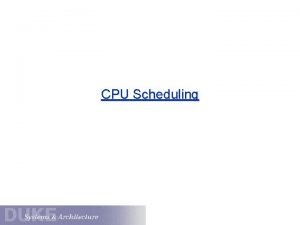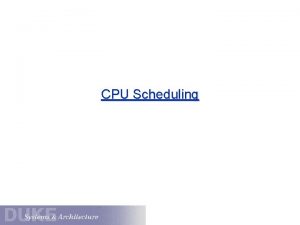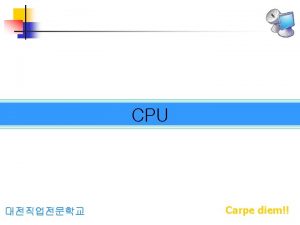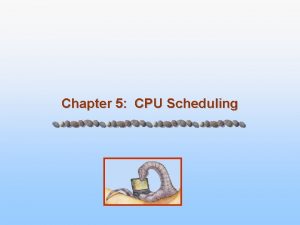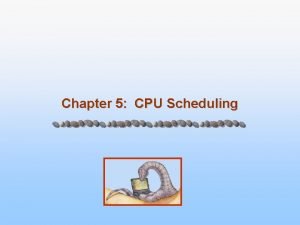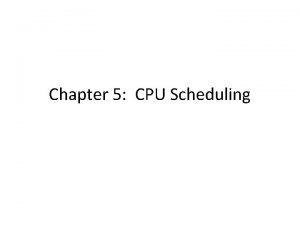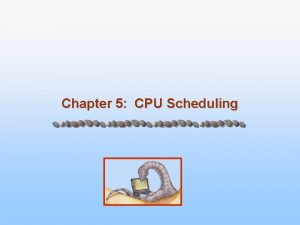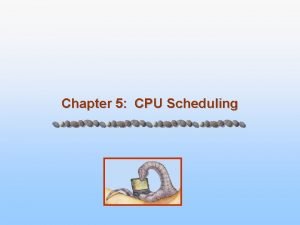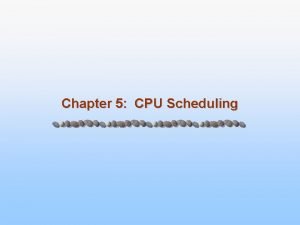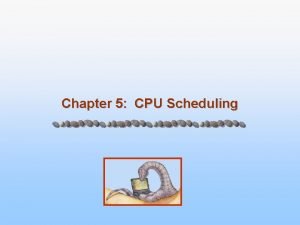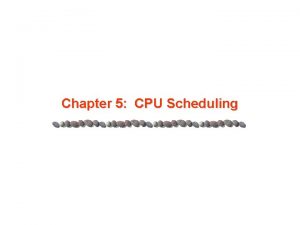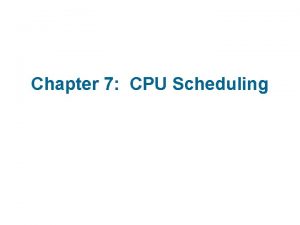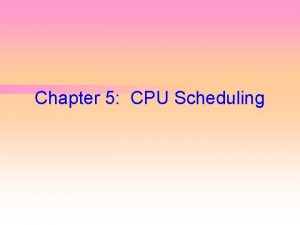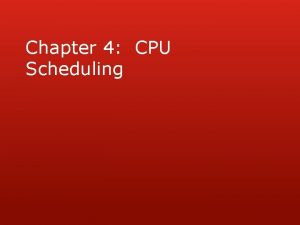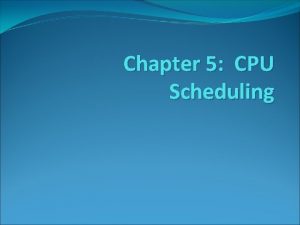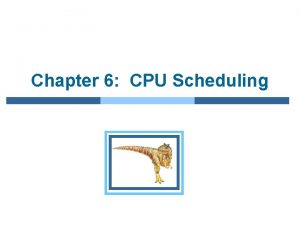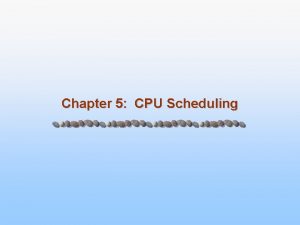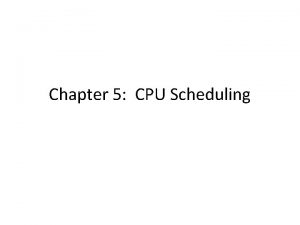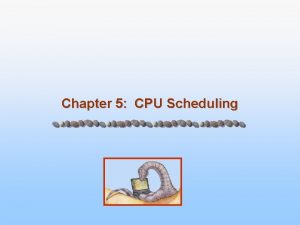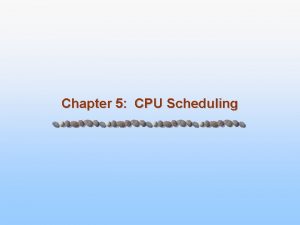Chapter 5 CPU Scheduling Chapter 5 CPU Scheduling















































- Slides: 47

Chapter 5: CPU Scheduling

Chapter 5: CPU Scheduling n Basic Concepts n Scheduling Criteria n Scheduling Algorithms n Multiple-Processor Scheduling n Real-Time Scheduling n Thread Scheduling n Operating Systems Examples n Java Thread Scheduling n Algorithm Evaluation CSCI 380 - Operating System 5. 2

Basic Concepts n Maximum CPU utilization obtained with multiprogramming n CPU–I/O Burst Cycle – Process execution consists of a cycle of CPU execution and I/O wait n CPU burst distribution CSCI 380 - Operating System 5. 3

Alternating Sequence of CPU And I/O Bursts CSCI 380 - Operating System 5. 4

Histogram of CPU-burst Times CSCI 380 - Operating System 5. 5

CPU Scheduler n Selects from among the processes in memory that are ready to execute, and allocates the CPU to one of them n CPU scheduling decisions may take place when a process: 1. Switches from running to waiting state 2. Switches from running to ready state 3. Switches from waiting to ready 4. Terminates n Scheduling under 1 and 4 is nonpreemptive n All other scheduling is preemptive l What does that mean? CSCI 380 - Operating System 5. 6

Dispatcher n Dispatcher module does the actual giving of control of the CPU to the process selected by the short-term scheduler; this involves: l switching context l switching to user mode l jumping to the proper location in the user program to restart that program n Dispatch latency – time it takes for the dispatcher to stop one process and start another running CSCI 380 - Operating System 5. 7

Scheduling Criteria n Must consider how to schedule, not as simple as you might think n CPU utilization – keep the CPU as busy as possible n Throughput – # of processes that complete their execution per time unit n Turnaround time – amount of time to execute a particular process n Waiting time – amount of time a process has been waiting in the ready queue (human nature to want this approach) n Response time – amount of time it takes from when a request was submitted until the first response is produced, not output (for time-sharing environment) CSCI 380 - Operating System 5. 8

Optimization Criteria n Max CPU utilization n Max throughput n Min turnaround time n Min waiting time n Min response time CSCI 380 - Operating System 5. 9

First-Come, First-Served (FCFS) Scheduling Process Burst Time P 1 24 P 2 3 P 3 3 n Suppose that the processes arrive in the order: P 1 , P 2 , P 3 The Gantt Chart for the schedule is: P 1 P 2 0 24 n Waiting time for P 1 = 0; P 2 = 24; P 3 = 27 n Average waiting time: (0 + 24 + 27)/3 = 17 CSCI 380 - Operating System 5. 10 P 3 27 30

FCFS Scheduling (Cont. ) Suppose that the processes arrive in the order P 2 , P 3 , P 1 n The Gantt chart for the schedule is: P 2 0 P 3 3 P 1 6 30 n Waiting time for P 1 = 6; P 2 = 0; P 3 = 3 n Average waiting time: (6 + 0 + 3)/3 = 3 n Much better than previous case n Convoy effect short process behind long process CSCI 380 - Operating System 5. 11

Shortest-Job-First (SJF) Scheduling n Associate with each process the length of its next CPU burst. Use these lengths to schedule the process with the shortest time n Two schemes: l nonpreemptive – once CPU given to the process it cannot be preempted until completes its CPU burst l preemptive – if a new process arrives with CPU burst length less than remaining time of current executing process, preempt. This scheme is know as the Shortest-Remaining-Time-First (SRTF) n SJF is optimal – gives minimum average waiting time for a given set of processes (if average waiting time was your only criteria) CSCI 380 - Operating System 5. 12

Example of Non-Preemptive SJF Process Arrival Time P 1 0. 0 7 P 2 2. 0 4 P 3 4. 0 1 P 4 5. 0 4 Burst Time n SJF (non-preemptive) P 1 0 3 P 3 7 P 2 8 n Average waiting time = (0 + 6 + 3 + 7)/4 = 4 CSCI 380 - Operating System 5. 13 P 4 12 16

Example of Preemptive SJF Process Arrival Time P 1 0. 0 7 P 2 2. 0 4 P 3 4. 0 1 P 4 5. 0 4 Burst Time n SJF (preemptive) P 1 0 P 2 2 P 3 4 P 2 5 P 4 P 1 11 7 n Average waiting time = (9 + 1 + 0 +2)/4 = 3 CSCI 380 - Operating System 5. 14 16

Determining Length of Next CPU Burst n Can only estimate the length n Can be done by using the length of previous CPU bursts, using exponential averaging CSCI 380 - Operating System 5. 15

Prediction of the Length of the Next CPU Burst CSCI 380 - Operating System 5. 16

Priority Scheduling n A priority number (integer) is associated with each process n The CPU is allocated to the process with the highest priority (smallest integer highest priority) l Preemptive l nonpreemptive n SJF is a priority scheduling where priority is the predicted next CPU burst time n Problem Starvation – low priority processes may never execute n Solution Aging – as time progresses increase the priority of the process CSCI 380 - Operating System 5. 18

Round Robin (RR) n Each process gets a small unit of CPU time (time quantum), usually 10 -100 milliseconds. After this time has elapsed, the process is preempted and added to the end of the ready queue. n If there are n processes in the ready queue and the time quantum is q, then each process gets 1/n of the CPU time in chunks of at most q time units at once. No process waits more than (n-1)q time units. n Performance l q large FIFO l q small q must be large with respect to context switch, otherwise overhead is too high CSCI 380 - Operating System 5. 19

Example of RR with Time Quantum = 20 Process Burst Time P 1 53 P 2 17 P 3 68 P 4 24 n The Gantt chart is: P 1 0 P 2 20 37 P 3 P 4 57 P 1 77 P 3 P 4 P 1 P 3 97 117 121 134 154 162 n Typically, higher average turnaround than SJF, but better response CSCI 380 - Operating System 5. 20

Time Quantum and Context Switch Time CSCI 380 - Operating System 5. 21

Turnaround Time Varies With The Time Quantum CSCI 380 - Operating System 5. 22

Multilevel Queue n Ready queue is partitioned into separate queues: foreground (interactive) background (batch) n Each queue has its own scheduling algorithm l foreground – RR l background – FCFS n Scheduling must be done between the queues l Fixed priority scheduling; (i. e. , serve all from foreground then from background). Possibility of starvation. l Time slice – each queue gets a certain amount of CPU time which it can schedule amongst its processes; i. e. , 80% to foreground in RR l 20% to background in FCFS CSCI 380 - Operating System 5. 23

Multilevel Queue Scheduling CSCI 380 - Operating System 5. 24

Multilevel Feedback Queue n A process can move between the various queues; aging can be implemented this way n Multilevel-feedback-queue scheduler defined by the following parameters: l number of queues l scheduling algorithms for each queue l method used to determine when to upgrade a process l method used to determine when to demote a process l method used to determine which queue a process will enter when that process needs service CSCI 380 - Operating System 5. 25

Example of Multilevel Feedback Queue n Three queues: l Q 0 – RR with time quantum 8 milliseconds l Q 1 – RR time quantum 16 milliseconds l Q 2 – FCFS n Scheduling l A new job enters queue Q 0 which is served FCFS. When it gains CPU, job receives 8 milliseconds. If it does not finish in 8 milliseconds, job is moved to queue Q 1. l At Q 1 job is again served FCFS and receives 16 additional milliseconds. If it still does not complete, it is preempted and moved to queue Q 2. CSCI 380 - Operating System 5. 26

Multilevel Feedback Queues CSCI 380 - Operating System 5. 27

Multiple-Processor Scheduling n CPU scheduling more complex when multiple CPUs are available n Homogeneous processors within a multiprocessor n Load sharing n Asymmetric multiprocessing – only one processor accesses the system data structures, alleviating the need for data sharing n Symmetric multiprocessing (SMP) – each processor has it’s own scheduler. May or may not share ready que. l Current OS’s implement this n What happens with multiple processors and their corresponding caches? Isn’t it inefficient to have processes move? CSCI 380 - Operating System 5. 28

Thread Scheduling n Local Scheduling – How the threads library decides which thread to put onto an available LWP n Global Scheduling – How the kernel decides which kernel thread to run next CSCI 380 - Operating System 5. 30

Pthread Scheduling API #include <pthread. h> #include <stdio. h> #define NUM THREADS 5 int main(int argc, char *argv[]) { int i; pthread t tid[NUM THREADS]; pthread attr t attr; /* get the default attributes */ pthread attr init(&attr); /* set the scheduling algorithm to PROCESS or SYSTEM */ pthread attr setscope(&attr, PTHREAD SCOPE SYSTEM); /* set the scheduling policy - FIFO, RT, or OTHER */ pthread attr setschedpolicy(&attr, SCHED OTHER); /* create threads */ for (i = 0; i < NUM THREADS; i++) pthread create(&tid[i], &attr, runner, NULL); CSCI 380 - Operating System 5. 31

Pthread Scheduling API /* now join on each thread */ for (i = 0; i < NUM THREADS; i++) pthread join(tid[i], NULL); } /* Each thread will begin control in this function */ void *runner(void *param) { printf("I am a threadn"); pthread exit(0); } CSCI 380 - Operating System 5. 32

Operating System Examples n Windows XP scheduling n Linux scheduling n Solaris scheduling CSCI 380 - Operating System 5. 33

Windows XP Priorities Reference p. 177 & 178 What’s it really doing? Lowest Number gets the CPU CSCI 380 - Operating System mixture of previous algorithms 5. 36

Linux Scheduling n Two algorithms: time-sharing and real-time n Time-sharing Prioritized credit-based – process with most credits is scheduled next l Credit subtracted when timer interrupt occurs l When credit = 0, another process chosen l When all processes have credit = 0, recrediting occurs 4 Based on factors including priority and history n Real-time l Soft real-time l l Posix. 1 b compliant – two classes 4 FCFS and RR 4 Highest priority process always runs first CSCI 380 - Operating System 5. 37

The Relationship Between Priorities and Time-slice length CSCI 380 - Operating System 5. 38

List of Tasks Indexed According to Prorities CSCI 380 - Operating System 5. 39

Algorithm Evaluation n Deterministic modeling – takes a particular predetermined workload and defines the performance of each algorithm for that workload n Queueing models n Implementation CSCI 380 - Operating System 5. 40

5. 15 CSCI 380 - Operating System 5. 41

End of Chapter 5

5. 08 CSCI 380 - Operating System 5. 43

In-5. 7 CSCI 380 - Operating System 5. 44

In-5. 8 CSCI 380 - Operating System 5. 45

In-5. 9 CSCI 380 - Operating System 5. 46

Dispatch Latency CSCI 380 - Operating System 5. 47

Java Thread Scheduling n JVM Uses a Preemptive, Priority-Based Scheduling Algorithm n FIFO Queue is Used if There Are Multiple Threads With the Same Priority CSCI 380 - Operating System 5. 48

Java Thread Scheduling (cont) JVM Schedules a Thread to Run When: 1. The Currently Running Thread Exits the Runnable State 2. A Higher Priority Thread Enters the Runnable State * Note – the JVM Does Not Specify Whether Threads are Time-Sliced or Not CSCI 380 - Operating System 5. 49

Time-Slicing Since the JVM Doesn’t Ensure Time-Slicing, the yield() Method May Be Used: while (true) { // perform CPU-intensive task. . . Thread. yield(); } This Yields Control to Another Thread of Equal Priority CSCI 380 - Operating System 5. 50

Thread Priorities Priority Comment Thread. MIN_PRIORITY Minimum Thread Priority Thread. MAX_PRIORITY Maximum Thread Priority Thread. NORM_PRIORITY Default Thread Priority Priorities May Be Set Using set. Priority() method: set. Priority(Thread. NORM_PRIORITY + 2); CSCI 380 - Operating System 5. 51
 Turnaround time in os
Turnaround time in os Preemptive priority scheduling
Preemptive priority scheduling Sjf cpu scheduling
Sjf cpu scheduling Fcfs gantt chart
Fcfs gantt chart Cpu i/o
Cpu i/o Sjf cpu scheduling
Sjf cpu scheduling Scheduling concepts
Scheduling concepts Preeptive
Preeptive Cpu scheduling project
Cpu scheduling project Scheduling della cpu
Scheduling della cpu Cpu scheduling project
Cpu scheduling project Sjn scheduling
Sjn scheduling Registro cude
Registro cude Cpu datapath
Cpu datapath I/o burst
I/o burst Partes internas y externas de una computadora
Partes internas y externas de una computadora Hdd bus
Hdd bus John cuda
John cuda Que es parte frontal
Que es parte frontal In this scheme cpu execution waits while i/o proceeds.
In this scheme cpu execution waits while i/o proceeds. Accumulator function cpu
Accumulator function cpu Homebrew cpu
Homebrew cpu Cpu consists of
Cpu consists of Cpu
Cpu I o interface
I o interface Kernel: initializing cgroup subsys cpuset
Kernel: initializing cgroup subsys cpuset Maqueta de las partes internas del cpu
Maqueta de las partes internas del cpu Processor history
Processor history The physical parts of a computer
The physical parts of a computer Hardware input
Hardware input Microsegundos
Microsegundos Spec cpu 2000
Spec cpu 2000 Tiga unsur penting dalam cpu adalah
Tiga unsur penting dalam cpu adalah Oma-dm client high cpu
Oma-dm client high cpu Cpu aufbau
Cpu aufbau Cpu performance equation examples
Cpu performance equation examples Cycles per instruction
Cycles per instruction Third gen computers
Third gen computers Input cpu output diagram
Input cpu output diagram Hardware definicion
Hardware definicion Cpu
Cpu Types of cpu architecture
Types of cpu architecture Cpu structure
Cpu structure Cpu is the heart of computer
Cpu is the heart of computer Kecepatan sebuah cpu dalam komputer diukur dalam satuan
Kecepatan sebuah cpu dalam komputer diukur dalam satuan Peralatan penyimpanan data diluar memori utama dan cpu
Peralatan penyimpanan data diluar memori utama dan cpu What is virtualization cpu
What is virtualization cpu Basic unit of cpu utilization
Basic unit of cpu utilization
